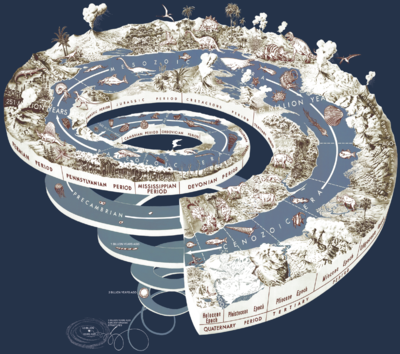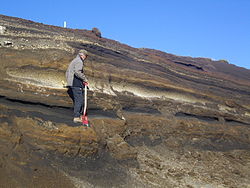- Geochronology
-
Geochronology is the science of determining the age of rocks, fossils, and sediments, within a certain degree of uncertainty inherent to the method used. A variety of dating methods are used by geologists to achieve this,[1][2] and schemes of classification and terminology have been proposed.[3] The interdisciplinary approach of using several methods can often achieve best results.
Geochronology is different in application from biostratigraphy, which is the science of assigning sedimentary rocks to a known geological period via describing, cataloguing and comparing fossil floral and faunal assemblages. Biostratigraphy does not directly provide an absolute age determination of a rock, but merely places it within an interval of time at which that fossil assemblage is known to have coexisted. Both disciplines work together hand in hand however, to the point they share the same system of naming rock layers and the time spans utilized to classify layers within a strata.
The science of geochronology is the prime tool used in the discipline of chronostratigraphy, which attempts to derive absolute age dates for all fossil assemblages and determine the geologic history of the Earth and extraterrestrial bodies.
Contents
Dating methods
Units in geochronology and stratigraphy[4] Segments of rock (strata) in chronostratigraphy Periods of time in geochronology Notes Eonothem Eon 4 total, half a billion years or more Erathem Era 10 total, several hundred million years System Period Series Epoch tens of millions of years Stage Age millions of years Chronozone Chron smaller than an age/stage, not used by the ICS timescale Radiometric dating
Main article: Radiometric datingBy measuring the amount of radioactive decay of a radioactive isotope with a known half-life, geologists can establish the absolute age of the parent material. A number of radioactive isotopes are used for this purpose, and depending on the rate of decay, are used for dating different geological periods. More slowly decaying isotopes are useful for longer periods of time, but less accurate in absolute years. With the exception of the radiocarbon method, most of these techniques are actually based on measuring an increase in the abundance of a radiogenic isotope, which is the decay-product of the radioactive parent isotope.[5][6][7] Two or more radiometric methods can be used in concert to achieve more robust results.[8] Most radiometric methods are suitable for geological time only, but some such as the radiocarbon method and the 40Ar/39Ar dating method can be extended into the time of early human life[9] and into recorded history.[10]
Some of the commonly-used techniques are:
- Radiocarbon dating. This technique measures the decay of carbon-14 in organic material and can be best applied to samples younger than about 60,000 years.[11]
- Uranium-lead dating. This technique measures the ratio of two lead isotopes (lead-206 and lead-207) to the amount of uranium in a mineral or rock. Often applied to the trace mineral zircon in igneous rocks, this method is one of the two most commonly used (along with argon-argon dating) for geologic dating. Uranium-lead dating is applied to samples older than about 1 million years.
- Uranium-thorium dating. This technique is used to date speleothems, corals, carbonates, and fossil bones. Its range is from a few years to about 700,000 years.
- Potassium-argon dating and argon-argon dating. These techniques date metamorphic, igneous and volcanic rocks. They are also used to date volcanic ash layers within or overlying paleoanthropologic sites. The younger limit of the argon-argon method is a few thousand years.
- Electron spin resonance dating (ESR dating)
Cosmogenic Nuclide Geochronology
Main article: Cosmogenic radionuclide datingA series of related techniques for determining the age at which a geomorphic surface was created (exposure dating), or at which formerly surficial materials were buried (burial dating). Exposure dating uses the concentration of exotic nuclides (e.g. 10Be, 26Al, 36Cl) produced by cosmic rays interacting with Earth materials as a proxy for the age at which a surface, such as an alluvial fan, was created. Burial dating uses the differential radioactive decay of 2 cosmogenic elements as a proxy for the age at which a sediment was screened by burial from further cosmic rays exposure.
Luminescence dating
Luminescence dating techniques observe 'light' emitted from materials such as quartz, diamond, feldspar, and calcite. Many types of luminescence techniques are utilized in geology, including optically stimulated luminescence (OSL), cathodoluminescence (CL), and thermoluminescence (TL). Thermoluminescence and optically stimulated luminescence are used in archaeology to date 'fired' objects such as pottery or cooking stones, and can be used to observe sand migration.
Incremental dating
Main article: Incremental datingIncremental dating techniques allow the construction of year-by-year annual chronologies, which can be fixed (i.e. linked to the present day and thus calendar or sidereal time) or floating.
Magnetostratigraphy
Main article: MagnetostratigraphyMagnetostratigraphy determines age from the pattern of magnetic polarity zones in a series of bedded sedimentary and/or volcanic rocks by comparison to the magnetic polarity timescale. The polarity timescale has been previously determined by dating of seafloor magnetic anomalies, radiometrically dating volcanic rocks within magnetostratigraphic sections, and astronomically dating magnetostratigraphic sections.
Correlation of marker horizons
Marker horizons are stratigraphic units of the same age and of such distinctive composition and appearance, that despite their presence in different geographic sites, there is certainty about their age-equivalence. Fossil faunal and floral assemblages, both marine and terrestrial, make for distinctive marker horizons.[12] Tephrochronology is a method for geochemical correlation of unknown volcanic ash (tephra) to geochemically-fingerprinted, dated tephra. Tephra is also often used as a dating tool in archaeology, since the dates of some eruptions are well-established.
Differences between chronostratigraphy and geochronology
It is important not to confuse geochronologic and chronostratigraphic units.[13] Geochronological units are periods of time, thus it is correct to say that Tyrannosaurus rex lived during the Late Cretaceous Epoch.[14] Chronostratigraphic units are geological material, so it is also correct to say that fossils of the genus Tyrannosaurus have been found in the Upper Cretaceous Series.[15] In the same way, it is entirely possible to go and visit an Upper Cretaceous Series deposit - such as the Hell Creek deposit where the Tyrannosaurus fossils were found - but it is naturally impossible to visit the Late Cretaceous Epoch as that is a period of time.
See also
- Age of the Earth
- List of geochronologic names
- Thermochronology
- Closure temperature
- Arthur Holmes
- Fritz Houtermans
- Alfred O. C. Nier
- Thomas Edvard Krogh
References
- ^ Renne, P.R., Ludwig, K.R. and Karner, D.B. 1998. Progress and challenges in geochronology. Science Progress, 83, 107-121 [1]
- ^ Noller, J.S., Sowers, J.M., and Lettis, W.R., 2000, Quaternary Geochronology: Methods and Applications, American Geophysical Union, AGU Reference Shelf 4.
- ^ Colman, S. M., Pierce, K. L., and Birkeland, P. W., 1987, Suggested terminology for Quaternary dating methods: Quaternary Research, v. 28, p. 314-319
- ^ International Commission on Stratigraphy. "International Stratigraphic Chart". Archived from the original on 2009-12-29. http://web.archive.org/web/20091229003212/http://www.stratigraphy.org/upload/ISChart2009.pdf.
- ^ Dickin, A. P. 1995. Radiogenic Isotope Geology. Cambridge, Cambridge University Press. ISBN 0-521-59891-5
- ^ Faure, G. 1986. Principles of isotope geology. Cambridge, Cambridge University Press. ISBN 0-471-86412-9
- ^ Faure, G., and Mensing, D. 2005. "Isotopes - Principles and applications". 3rd Edition. J. Wiley & Sons. ISBN 0-471-38437-2
- ^ Dalrymple G.B., Grove M., Lovera O.M., Harrison, T.M., Hulen, J.B., and Lanphere, M.A. 1999. Age and thermal history of the Geysers plutonic complex (felsite unit), Geysers geothermal field, California: a 40Ar/39Ar and U–Pb study. Earth and Planetary Science Letters, 173, 285–298 [2]
- ^ Ludwig, K.R. and Renne, P.R. 2000. Geochronology on the Paleoanthropological Time Scale. Evolutionary Anthropology, 9, 101-110 [3]
- ^ Renne, P.R., Sharp, W.D., Deino. A.L., Orsi, G., and Civetta, L. 1997. 40Ar/39Ar dating into the historical realm: Calibration against Pliny the Younger. Science, 277, 1279-1280 [4]
- ^ Plastino, W.; Kaihola, L.; Bartolomei, P.; Bella, F. (2001). "Cosmic Background Reduction In The Radiocarbon Measurement By Scintillation Spectrometry At The Underground Laboratory Of Gran Sasso". Radiocarbon 43 (2A): 157–161. https://digitalcommons.library.arizona.edu/objectviewer?o=http%3A%2F%2Fradiocarbon.library.arizona.edu%2Fvolume43%2Fnumber2A%2Fazu_radiocarbon_v43_n2a_157_161_v.pdf.
- ^ Demidov, I.N. 2006. Identification of marker horizon in bottom sediments of the Onega Periglacial Lake. Doklady Earth Sciences, 407, 213-216 [5]
- ^ David Weishampel:The Evolution and Extinction of the Dinosaurs, 1996, Cambridge Press, ISBN 0-521-44496-9
- ^ Julia Jackson: Glossary of Geology, 1987, American Geological Institute, ISBN 0-922152-34-9
- ^ Smith, J.B., Lamanna, M.C., Lacovara, K.J., Dodson, P. Jnr., Poole, J.C. and Giegengack, R. 2001. A Giant Sauropod Dinosaur from an Upper Cretaceous Mangrove Deposit in Egypt. Science, 292, 1704-1707 [6]
Further reading
- Lowe, J.J., and Walker, M.J.C. (1997), Reconstructing Quaternary Environments (2nd edition). Longman publishing ISBN 0-582-10166-2
- Smart, P.L., and Frances, P.D. (1991), Quaternary dating methods - a user's guide. Quaternary Research Association Technical Guide No.4 ISBN 0907780083
- Geochronology bibliography Talk:Origins Archive
External links
Time Major concepts Time · Eternity · Arguments for eternity · Immortality
Deep time · History · Past · Present · Future · Future studies
 Time Portal
Time PortalMeasurement and standards Chronometry · UTC · UT · TAI · Second · Minute · Hour · Sidereal time · Solar time · Time zone
Clock · Astrarium · History of timekeeping devices · Horology · Marine chronometer · Sundial · Water clock
Calendar · Day · Week · Month · Year · Tropical year · Gregorian · Islamic · Julian
Intercalation · Leap second · Leap yearChronology Astronomical chronology · Calendar era · Chronicle · Dating methodologies · Geochronology
Geologic Time · Geological history · Periodization · Regnal year · TimelineReligion and mythology Philosophy Physical sciences Biology Psychology Sociology and anthropology Economics Related topics Chronology Main articles Time · Astronomy · Geology · Paleontology · Archaeology · History
Eras and epochs Canon of Kings · Lists of kings · Limmu · Seleucid era
Astronomic time Geologic time ConceptsStandardsMethodsChronostratigraphy · Geochronology · Isotope geochemistry · Law of superposition · Optical dating · Samarium-neodymium dating
Archaeological
methodsGenetic methods Related topics Chronicle · New Chronology · Periodization · Synchronoptic view · Timeline · Year zero · Circa · Floruit · ASPRO chronology
Categories:
Wikimedia Foundation. 2010.


